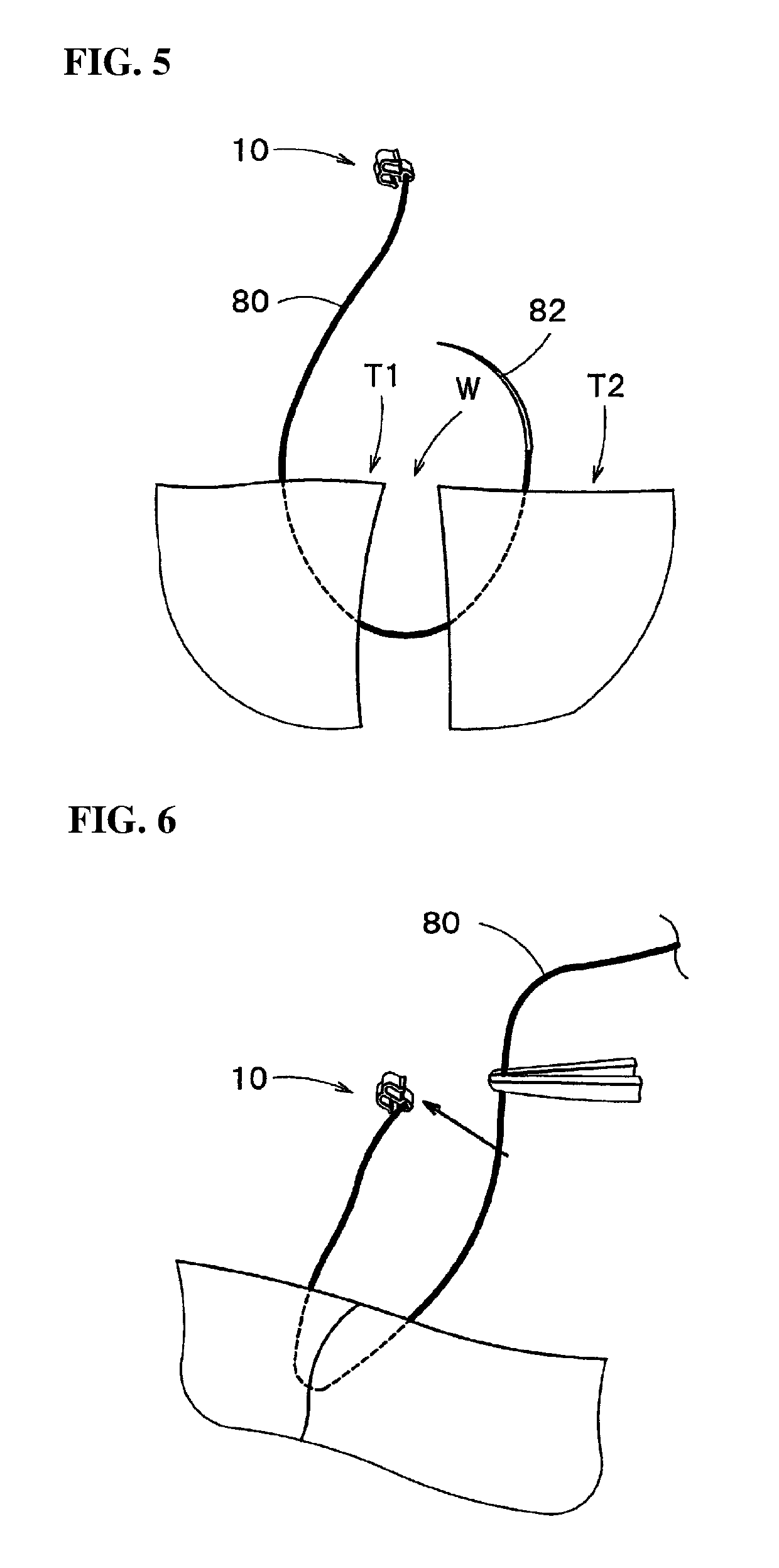Tissue ligating device
a tissue ligating device and tissue technology, applied in the field can solve the problems of high difficulty, critical complication, and require a lot of skill, and achieve the effects of improving the procedure of guiding, reducing the load on operators, and improving the usability of tissue ligating devices
- Summary
- Abstract
- Description
- Claims
- Application Information
AI Technical Summary
Benefits of technology
Problems solved by technology
Method used
Image
Examples
first embodiment
[0056]FIG. 1 is a schematic plan view showing a tissue ligating device in the present invention. FIG. 2 is a schematic perspective view showing the tissue ligating device of FIG. 1. FIG. 3 is a schematic perspective view showing a state in which a suture thread has been fixed to a first fixation part of the tissue ligating device of FIG. 1.
[0057]As shown in FIGS. 1 to 3, the tissue ligating device 10 in this embodiment includes a first fixation part 11 to which a base end part 81 of a suture thread 80 is fixed and a second fixation part 12 configured to allow insertion of the suture thread 80 therethrough and allow to be crimped so as to newly fix a part of the suture thread 80, and thereby to define a loop starting from the base end part 81, in a state after ligation of tissue is performed. A suture needle 82 is attached to a tip end part of the suture thread 80.
[0058]The first fixation part 11 in this embodiment is configured to allow insertion of the suture thread 80 therethrough...
second embodiment
[0085]Next, FIG. 11 is a schematic plan view showing a tissue ligating device in the present invention.
[0086]As shown in FIG. 11, the tissue ligating device 20 in this embodiment includes a first fixation part 21 to which a base end part 81 of a suture thread 80 is fixed and a second fixation part configured to allow insertion of the suture thread 80 therethrough and allow to be crimped so as to newly fix a part of the suture thread 80, and thereby to define a loop starting from the base end part 81, in a state after ligation of tissue is performed.
[0087]The first fixation part 21 in this embodiment is configured to allow insertion of the suture thread 80 therethrough and allow to be crimped, thereby to fix a part of the suture thread 80 as the base end part 81, in a state before ligation of tissue is performed. In FIG. 11, a state before the crimping is shown.
[0088]The second fixation part 22 in this embodiment includes a back side (left-hand side in FIG. 11) wall part 22B, a front...
third embodiment
[0104]Next, FIG. 12 is a schematic plan view showing a tissue ligating device in the present invention.
[0105]As shown in FIG. 12, the tissue ligating device 30 in this embodiment includes a first fixation part 31 to which a base end part 81 of a suture thread 80 is fixed and a second fixation part configured to allow insertion of the suture thread 80 therethrough and allow to be crimped so as to newly fix a part of the suture thread 80, and thereby to define a loop starting from the base end part 81, in a state after ligation of tissue is performed.
[0106]The first fixation part 31 in this embodiment is configured to allow insertion of the suture thread 80 therethrough and allow to be crimped, thereby to fix a part of the suture thread 80 as the base end part 81, in a state before ligation of tissue is performed. In FIG. 12, a state before the crimping is shown.
[0107]The second fixation part 32 in this embodiment includes a back side (left-hand side in FIG. 12) wall part 32B, a front...
PUM
 Login to View More
Login to View More Abstract
Description
Claims
Application Information
 Login to View More
Login to View More - R&D
- Intellectual Property
- Life Sciences
- Materials
- Tech Scout
- Unparalleled Data Quality
- Higher Quality Content
- 60% Fewer Hallucinations
Browse by: Latest US Patents, China's latest patents, Technical Efficacy Thesaurus, Application Domain, Technology Topic, Popular Technical Reports.
© 2025 PatSnap. All rights reserved.Legal|Privacy policy|Modern Slavery Act Transparency Statement|Sitemap|About US| Contact US: help@patsnap.com



